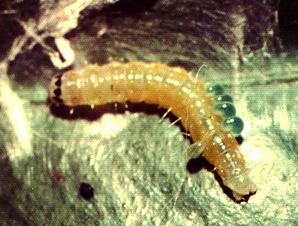
Caterpillar with attached green mites
(Photo: Don Herbison-Evans, Sydney, New South Wales)
This Caterpillar is small and green, and is named after
the four prominent black stripes on its head.
These are merely pigmentation, and not actually eyes.
The skin is nearly transparent, and the male can be distinguished
by the pale yellow pair of gonads
about two thirds the way along the body, straddling
the main green blood vessel running down the centre of the back.
The last abdominal segment and anal
prolegs are white with a
bluish tinge.
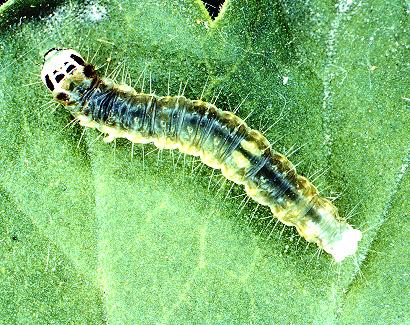
Male Caterpillar with gonads showing
(Photo: Don Herbison-Evans, Sydney, New South Wales)
The caterpillar lives between leaves joined together with silk.
If disturbed, it has several escape strategies:
it can wriggle violently backwards, or drop on a thread,
or exude a nasty dark green liquid from its mouth.
It seems to feed on nearly any plant foliage.
It has been found on many plants, particularly:
Ivy ( Hedera helix,
ARALIACEAE ),
and is a pest on:
Avocado ( Persea americana,
LAURACEAE ),
and feeds on plants from many other families, including:
Honeysuckle ( Lonicera,
CAPRIFOLIACEAE ),
Running Postman ( Kennedia prostrata ,
FABACEAE ),
Privet ( Ligustrum,
OLEACEAE,
Clematis ( Clematis glycinoides,
RANUNCULACEAE ),
Strawberry ( Fragaria ananassa,
ROSACEAE,
Citrus ( Citrus,
RUTACEAE ),
Poplar ( Populus,
SALICACEAE ),
Wombat Berry ( Eustrephus latifolius,
SMILACACEAE ),
Lantana ( Lantana camara,
VERBENACEAE ),
as well as
Byfield Fern ( Bowenia serrulata,
CYCADELES ), and
Mangrove Fern ( Acrostichum aureum,
POLYPODIOPHYTA ).
The Caterpillar grows to a length of about 2 cms.
It pupates in its leafy shelter.
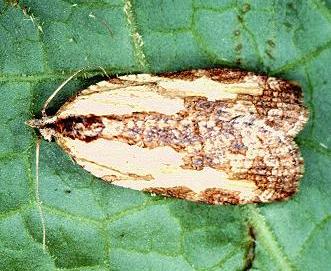
Female adult moth resting
(Photo: courtesy of Merlin Crossley, Melbourne, Victoria)
The patterns of the male and female adults differ:
the female has a subtle pattern of light and dark brown patches.
She is also larger with a wingspan of about 3 cms.
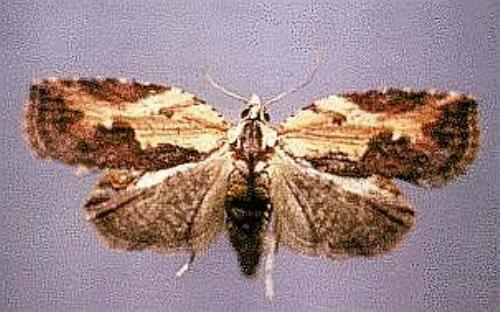
Female adult moth
(Specimen: courtesy of the
Macleay Collection, Chau Chak Wing Museum, University of Sydney)
The male is more uniformly dark brown with
a golden area near the wing roots. He has
a smaller wingspan: about 2.5 cms.
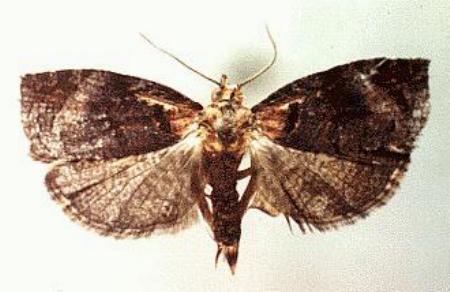
Male adult moth
(Specimen: courtesy of the
Macleay Collection, Chau Chak Wing Museum, University of Sydney)
The moths rest so that their wings make a shape like the outline of a bell.
Whilst the males are uniquely patterned,
the females are similar to those of the related species
Cryptoptila australana.
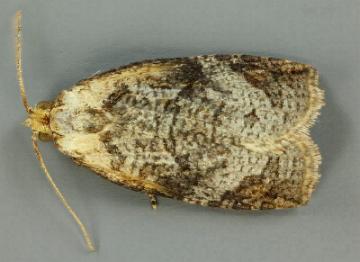
Male adult moth resting
(Photo: courtesy of
Aila Keto,
Springbrook, Queensland)
The species has been reported in
Queensland,
New South Wales,
Australian Capital Territory,
Victoria,
Tasmania,
South Australia, and
Western Australia.
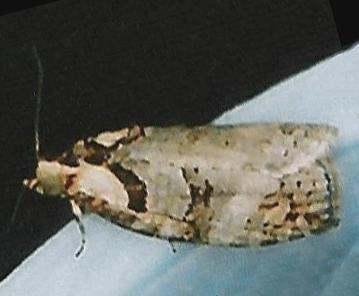
Male adult moth resting
(Photo: courtesy of
Susan Foyle, Sydney, New South Wales)
Further reading :
Ian F.B. Common,
Moths of Australia,
Melbourne University Press, 1990, pl. 24.10, pp. 68, 278.
Francis Walker,
Tortricites & Tineites,
List of the Specimens of Lepidopterous Insects in the Collection of the British Museum,
Part 28 (1863), p. 302, No. 69.
(updated 3 September 2011, 12 November 2025)












